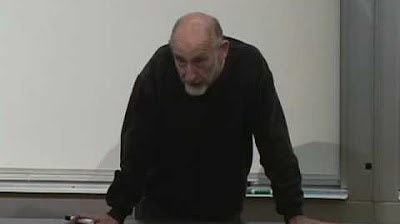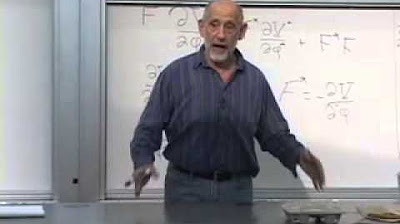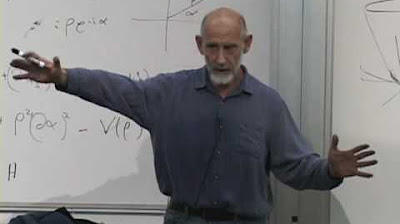Lecture 6 | New Revolutions in Particle Physics: Standard Model
TLDRThe transcript appears to be a lecture on quantum chromodynamics (QCD) and the Standard Model of particle physics, focusing on the role of symmetry groups like SU(3) and SU(2) in describing the interactions of quarks and leptons. The lecturer discusses the concept of color charge in QCD and how the SU(3) symmetry group, associated with the strong nuclear force, acts on quarks. They also delve into the generation of gluons and the role of gauge bosons, emphasizing the one-to-one correspondence between the generators of SU(3) and the emission of gluons. The lecture further explores flavor symmetry, the W and Z bosons, and the weak interaction processes. It touches on the mathematical structure of the Standard Model, including the product structure of the gauge group SU(3) x SU(2) x U(1), and the coupling constants associated with different interactions. The script also investigates the reasons behind the weakness of weak interactions, highlighting the large mass of the W boson and its impact on decay rates. The lecturer concludes with a brief introduction to spontaneous symmetry breaking, a phenomenon that will be further explored in relation to the Higgs mechanism in a subsequent lecture.
Takeaways
- 🚩 The script discusses the Standard Model of particle physics, focusing on the role of SU(3) and SU(2) symmetries, which are crucial for understanding quantum chromodynamics (QCD) and electroweak interactions.
- 🔵 SU(3) symmetry, associated with QCD, acts on the color charge of quarks, allowing for the transformation between red, green, and blue quarks, and is represented by gluons.
- 🟢 SU(2) symmetry, also known as flavor or family symmetry, allows for the transformation between different types of quarks (up, down, charm, strange, top, bottom) while keeping the color charge unchanged.
- 📊 The script introduces the concept of gauge bosons, which are particles that mediate the force of the symmetry group and are responsible for the interactions between other particles.
- ⚛️ The gluon, a gauge boson of SU(3), has a high probability of being emitted due to the strong force, unlike photons which are emitted less frequently due to the weaker electromagnetic force.
- 🧲 The W and Z bosons are gauge bosons associated with the weak nuclear force, and their discovery was significant for the understanding of electroweak interactions.
- 🤔 The script raises questions about the nature of weak interactions and why they are weaker despite having a coupling constant of similar magnitude to that of quantum electrodynamics.
- ⏳ The lifetime of the W boson and the probability of weak interactions are influenced by the large mass of the W boson, which results in a rapid decrease in the propagator's value at a distance proportional to the Compton wavelength of the W boson.
- 🌌 The script touches on the concept of virtual particles, which are temporary fluctuations that can last for a short time and can be converted into real particles under certain conditions.
- ⚖️ The principle of energy conservation is maintained in quantum mechanics through the uncertainty principle, which allows for temporary violations of energy conservation.
- 🔬 The discussion also explores the philosophical and interpretative challenges in particle physics, such as the idea that what comes out of a system may not necessarily reflect what was in there beforehand.
Q & A
What is the significance of the SU(3) symmetry in the context of Quantum Chromodynamics (QCD)?
-SU(3) symmetry is associated with Quantum Chromodynamics (QCD), which is the theory of the strong force that binds quarks together to form protons, neutrons, and other hadrons. The symmetry acts on the color charge of quarks, allowing for the transformation between the three color states (red, green, and blue), and is fundamental for understanding the interactions and behavior of quarks within the standard model of particle physics.
How does the emission of a gluon relate to the SU(3) symmetry?
-The emission of a gluon is a physical manifestation of the transformation associated with the SU(3) symmetry. Gluons are the gauge bosons that mediate the strong force between quarks, and their emission corresponds to the generators of the SU(3) group. This means that the act of a quark emitting a gluon is equivalent to an infinitesimal transformation within the SU(3) group, which is responsible for the mixing of color states.
What is the role of the W boson in the process of weak interactions?
-The W boson plays a crucial role in mediating the weak interactions, which are responsible for processes such as beta decay. When a quark undergoes a transformation due to weak interaction, such as a down quark becoming an up quark, a W boson is emitted or absorbed in the process. This W boson can subsequently decay into a lepton and an antineutrino, thus facilitating the change in the quark's flavor while conserving charge and other quantum numbers.
How does the mass of the W boson affect the probability of weak interactions?
-The mass of the W boson has a significant impact on the probability of weak interactions occurring. The propagator for the W boson, which accounts for its motion from the point of emission to the point of absorption, decreases exponentially with increasing mass. This means that the heavier the W boson, the less likely it is for weak interactions to take place, as the probability amplitude for the emission of a W boson is inversely proportional to the square of its mass.
What is the concept of flavor symmetry and how does it differ from color symmetry?
-Flavor symmetry, sometimes referred to as family symmetry, is a symmetry that involves transformations between different types of quarks while keeping their color unchanged. This is in contrast to color symmetry, which is associated with the strong force and involves transformations between the color states of quarks. Flavor symmetry transformations can change the 'flavor' of quarks, such as turning an up quark into a down quark, while color symmetry transformations mix the color states of quarks.
What is the relationship between the electric charge and the U(1) symmetry?
-The U(1) symmetry is associated with the emission of a photon in electrodynamics. The coupling constant for this symmetry, which is essentially the electric charge, determines the probability of photon emission. Every charged field transforms with a phase under U(1), and the amplitude for the emission of a photon is proportional to the electric charge. When squared, this charge gives the fine-structure constant, which is a measure of the strength of the electromagnetic interaction.
How does the standard model describe the gauge group structure?
-The standard model describes the gauge group structure as a product of three separate symmetries: SU(3) for color, SU(2) for weak interactions, and U(1) for electrodynamics. This structure, denoted as SU(3) x SU(2) x U(1), indicates that the symmetries do not mix with each other; the SU(2) transformations do not affect the color states, and the SU(3) transformations do not affect the upness or downness of quarks.
What is the significance of the fine-structure constant in quantum electrodynamics?
-The fine-structure constant, denoted by α, is the coupling constant associated with the emission of a photon in quantum electrodynamics. It is a dimensionless number that represents the strength of the electromagnetic interaction between charged particles. The probability of photon emission is proportional to the square of this constant, and it is a fundamental parameter in the quantum mechanical description of electromagnetic processes.
What is the role of the Higgs boson in the standard model?
-The Higgs boson plays a crucial role in the standard model as it is responsible for the mechanism of spontaneous symmetry breaking and the generation of masses for the fundamental particles. The Higgs mechanism is a process by which gauge bosons, such as the W and Z bosons, acquire mass, while fermions get their masses through their interactions with the Higgs field.
What is the concept of spontaneous symmetry breaking in particle physics?
-Spontaneous symmetry breaking is a phenomenon in which a system, despite having a symmetrical laws of motion, ends up in a state that is not symmetrical. In particle physics, this concept is used to explain how particles acquire mass. The most famous example is the Higgs mechanism, where the Higgs field, through spontaneous symmetry breaking, gives mass to the W and Z bosons, and to fermions via Yukawa coupling.
How does the concept of virtual particles relate to energy conservation in quantum mechanics?
-Virtual particles are temporary fluctuations that can appear in quantum field theory, and they can lead to apparent violations of energy conservation. However, these violations are temporary and are in accordance with the Heisenberg uncertainty principle, which allows for short-lived energy non-conservation as long as the product of the energy violation and the time it exists is less than or equal to the reduced Planck constant. This principle is fundamental to understanding processes such as quantum tunneling and the creation and annihilation of particle-antiparticle pairs.
Outlines
😀 Quantum Chromodynamics (QCD) and Fermions
The first paragraph introduces the concept of Quantum Chromodynamics (QCD) and its associated symmetry group SU(3). It discusses how this symmetry acts on the color charge of quarks, which are the constituents of particles in the standard model. The paragraph also explains the structure of the table representing fermions and how the SU(3) generators correspond to the gluons, which are the mediator particles of the strong force.
🔬 Flavor Symmetry and Weak Interactions
The second paragraph delves into the flavor symmetry, also known as family symmetry, which is associated with the weak interactions. It explains how this symmetry can transform quarks from one family to another while keeping the color charge unchanged. The W bosons are introduced as the gauge bosons that mediate these weak interactions, and the paragraph outlines the difference between the behavior of gluons and W bosons in terms of their effect on quark color and family.
🧲 Coupling Constants and Interaction Probabilities
The third paragraph discusses the coupling constants for various interactions, such as the electromagnetic interaction associated with the photon and the strong interaction associated with the gluon. It highlights the difference in probabilities of emission for these particles, with gluons being much more likely to be emitted than photons. The paragraph also touches on the concept of weak interactions being less probable due to the nature of the processes involved, rather than the size of the coupling constant.
🤔 Leptons and Their Interactions
The fourth paragraph expands on the topic by introducing leptons, which, unlike quarks, do not carry color charge and thus do not participate in color interactions. It discusses the pattern of charges among leptons and their antiparticles, and how the emission of a W boson can occur under specific conditions related to charge difference. The paragraph also clarifies the historical terminology used to describe particles, such as mesons and baryons.
📐 Feynman Diagrams and Propagators
The fifth paragraph focuses on Feynman diagrams, which are used to visualize the behavior of subatomic particles. It explains the components of these diagrams, such as vertices and propagators, which account for the motion of particles. The discussion centers on the propagator for the W boson and how its mass affects the probability of a particle traveling a certain distance before decaying.
🤓 Fourier Transforms and Interaction Amplitudes
The sixth paragraph explores the relationship between momentum and position in quantum field theory through Fourier transforms. It describes how the propagator can be viewed as a function of either position or momentum and how the Fourier transform of the propagator is related to the amplitude for emitting a W boson with a given momentum. The paragraph also discusses how the mass of the W boson influences the likelihood of weak interactions.
🧲 The Weak Interactions and the W Boson
The seventh paragraph continues the discussion on weak interactions, emphasizing why they are weak due to the large mass of the W boson. It explains that the weakness is not due to a small coupling constant but rather the large mass of the W boson, which results in a small probability for the interaction to occur. The paragraph also touches on the historical context of how the weak interaction was characterized experimentally.
🕳️ Black Holes and Virtual Particles
The eighth paragraph ventures into the topic of black holes and virtual particles. It discusses the possibility of particles falling into black holes and, by time-reversal invariance, black holes emitting particles. The paragraph highlights that any process, no matter how unlikely, can occur if given enough opportunities, as dictated by the entropy of the black hole.
🤔 Quantum Mechanics and Particle Interactions
The ninth paragraph delves into the principles of quantum mechanics, particularly the concept of virtual particles and their interactions. It explains that virtual particles, while not directly observable, can be inferred from their effects on physical systems. The discussion also touches on the creation of real particles from virtual ones through the input of sufficient energy.
🔍 Observing Particles and Vacuum Fluctuations
The tenth paragraph discusses the challenges of observing particles, particularly virtual particles, without disrupting their state. It highlights the Heisenberg uncertainty principle and its implications for the observation of particles and the energy required to create them. The paragraph also touches on vacuum fluctuations and the potential for creating particle-antiparticle pairs.
🧲 Spontaneous Symmetry Breaking and the Higgs Mechanism
The eleventh paragraph introduces the concept of spontaneous symmetry breaking, using the analogy of people choosing between two forks to illustrate the idea. It sets the stage for a deeper discussion on the Higgs mechanism, which is a phenomenon of spontaneous symmetry breaking that gives particles their mass.
🔧 The Ground State and Domain Walls
The twelfth paragraph expands on the concept of spontaneous symmetry breaking by discussing the ground state of a system and the formation of domain walls. It explains how an instability in the system can lead to a preference for one state over another, even when the system is symmetric. The presence of domain walls is presented as evidence of spontaneous symmetry breaking.
🧲 The Higgs Phenomenon and Particle Mass
The thirteenth paragraph concludes the discussion by connecting the concept of spontaneous symmetry breaking to the Higgs phenomenon. It suggests that the Higgs mechanism, which is responsible for giving particles mass, will be discussed in more detail in subsequent sessions.
Mindmap
Keywords
💡Quantum Chromodynamics (QCD)
💡SU(3) Symmetry
💡Fermions
💡Gluons
💡Weak Interactions
💡W and Z Bosons
💡Electrodynamics
💡Standard Model
💡Gauge Bosons
💡Color Charge
💡Flavor Symmetry
Highlights
SU(3) is associated with Quantum Chromodynamics (QCD) and acts on the color symmetry of quarks, mixing red, green, and blue.
The Standard Model's fermions are organized into families, with the up/down family, charm/strange family, and top/bottom family representing the horizontal structure.
SU(3) symmetry corresponds to gluons, which are emitted when one quark transforms into another, maintaining color symmetry.
Gauge bosons, such as gluons, are manifestations of symmetry groups and are involved in particle transformations.
Flavor symmetry, or family symmetry, allows for processes where up quarks can transform into down quarks, and charm into strange, without changing color.
W bosons mediate flavor changes and are responsible for the horizontal movement within the fermion families.
The Standard Model is a gauge theory based on the gauge group SU(3) x SU(2) x U(1), representing the product structure of color, weak, and electromagnetic interactions.
The U(1) symmetry is associated with the emission of a photon and the electric charge, which is the fine-structure constant.
The strong interaction coupling constant, G, is associated with the emission of a gluon and is close to the fine-structure constant, indicating a high probability of gluon emission.
Weak interactions, despite their name, have a coupling constant of a similar order of magnitude to that of quantum electrodynamics, but their probability is reduced due to the mass of the W boson.
The decay of a neutron into a proton involves a down quark emitting a W- boson and becoming an up quark.
Leptons, unlike quarks, do not carry color and do not participate in color interactions, but they do follow a similar pattern to quarks in terms of charge differences.
The emission of a W boson is possible when the charge difference between the initial and final fermions is correct, as seen with neutrinos and electrons.
The probability of weak interactions is controlled by the mass of the W boson, with heavier W bosons resulting in less probable interactions.
The lifetime of a particle, such as the W boson, is related to its decay probability, which is influenced by its mass and the available energy.
Virtual particles, like the W boson, can be observed under certain conditions, such as when enough energy is supplied to create them.
Spontaneous symmetry breaking is a phenomenon where a system with symmetrical potential energy surfaces can end up in a unique ground state due to instabilities.
Domain walls are a signature of spontaneous symmetry breaking, where a boundary forms between regions of different ground states.
Transcripts
Browse More Related Video

Lecture 4 | New Revolutions in Particle Physics: Standard Model

Particle Physics is Founded on This Principle!

Supersymmetry & Grand Unification: Lecture 9

Lecture 5 | New Revolutions in Particle Physics: Standard Model

Lecture 8 | New Revolutions in Particle Physics: Standard Model

What Makes The Strong Force Strong?
5.0 / 5 (0 votes)
Thanks for rating: